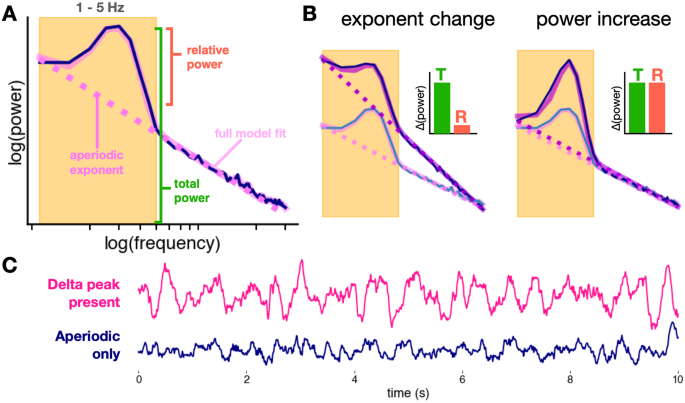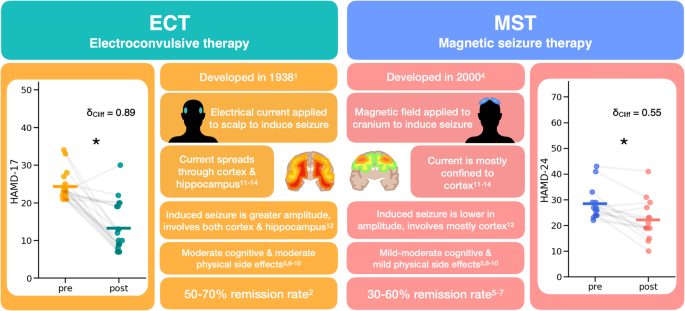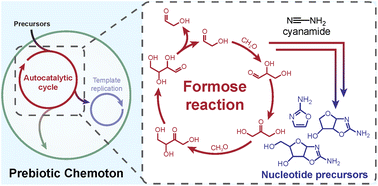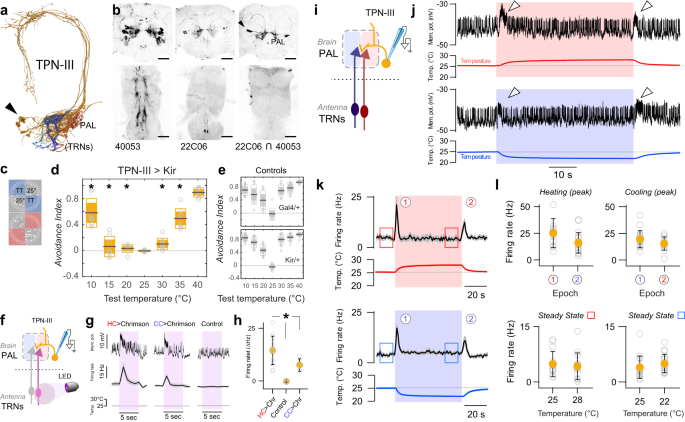2023-11-16 カリフォルニア大学サンディエゴ校(UCSD)
◆ECTはうつ病などの治療に有効ですが、その効果の理由は不明瞭でした。研究者は患者の脳波を調査し、ECTにより非周期的な活動が増加することを確認しました。この活動は脳の制御に寄与し、神経細胞の興奮と抑制のサイクルを調整する役割を果たしている可能性があります。今後の研究で治療の効果を評価し、うつ病治療における新たな手法の開発が期待されています。
<関連情報>
- https://today.ucsd.edu/story/new-studies-of-brain-activity-explain-benefits-of-electroconvulsive-therapy
- https://www.nature.com/articles/s41398-023-02634-9
- https://www.nature.com/articles/s41398-023-02631-y
電気けいれん療法によって誘発される臨床脳波の低下は、前頭部の非周期的活動の増加によってよりよく説明される。 Clinical EEG slowing induced by electroconvulsive therapy is better described by increased frontal aperiodic activity
Sydney E. Smith,Vincent Ma,Celene Gonzalez,Angela Chapman,David Printz,Bradley Voytek & Maryam Soltani
Translational Psychiatry Published:16 November 2023
DOI:https://doi.org/10.1038/s41398-023-02634-9

Abstract
Electroconvulsive therapy (ECT) is one of the most efficacious interventions for treatment-resistant depression. Despite its efficacy, ECT’s neural mechanism of action remains unknown. Although ECT has been associated with “slowing” in the electroencephalogram (EEG), how this change relates to clinical improvement is unresolved. Until now, increases in slow-frequency power have been assumed to indicate increases in slow oscillations, without considering the contribution of aperiodic activity, a process with a different physiological mechanism. In this exploratory study of nine MDD patients, we show that aperiodic activity, indexed by the aperiodic exponent, increases with ECT treatment. This increase better explains EEG “slowing” when compared to power in oscillatory peaks in the delta (1–3 Hz) range and is correlated to clinical improvement. In accordance with computational models of excitation-inhibition balance, these increases in aperiodic exponent are linked to increasing levels of inhibitory activity, suggesting that ECT might ameliorate depressive symptoms by restoring healthy levels of inhibition in frontal cortices.
磁気けいれん療法と電気けいれん療法は非周期的活動を増加させる Magnetic seizure therapy and electroconvulsive therapy increase aperiodic activity
Sydney E. Smith,Eena L. Kosik,Quirine van Engen,Jordan Kohn,Aron T. Hill,Reza Zomorrodi,Daniel M. Blumberger,Zafiris J. Daskalakis,Itay Hadas &Bradley Voytek
Translational Psychiatry Published:16 November 2023
DOI:https://doi.org/10.1038/s41398-023-02631-y

Abstract
Major depressive disorder (MDD) is a leading cause of disability worldwide. One of the most efficacious treatments for treatment-resistant MDD is electroconvulsive therapy (ECT). Recently, magnetic seizure therapy (MST) was developed as an alternative to ECT due to its more favorable side effect profile. While these approaches have been very successful clinically, the neural mechanisms underlying their therapeutic effects are unknown. For example, clinical “slowing” of the electroencephalogram beginning in the postictal state and extending days to weeks post-treatment has been observed in both treatment modalities. However, a recent longitudinal study of a small cohort of ECT patients revealed that, rather than delta oscillations, clinical slowing was better explained by increases in aperiodic activity, an emerging EEG signal linked to neural inhibition. Here we investigate the role of aperiodic activity in a cohort of patients who received ECT and a cohort of patients who received MST treatment. We find that aperiodic neural activity increases significantly in patients receiving either ECT or MST. Although not directly related to clinical efficacy in this dataset, increased aperiodic activity is linked to greater amounts of neural inhibition, which is suggestive of a potential shared neural mechanism of action across ECT and MST.


